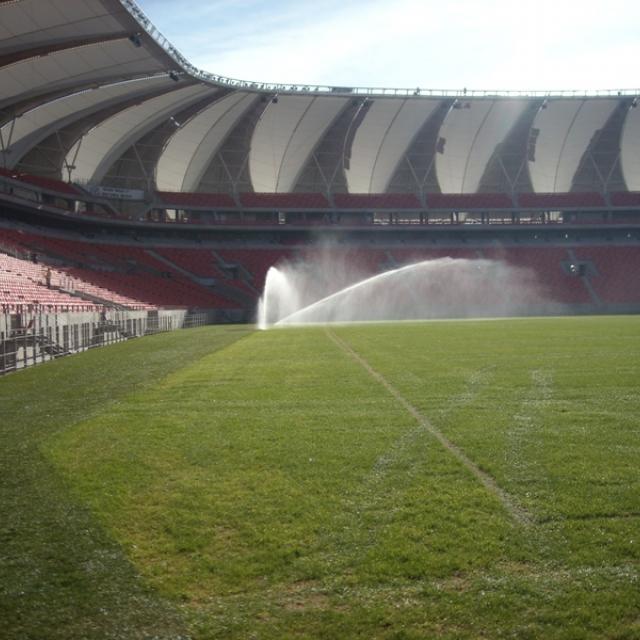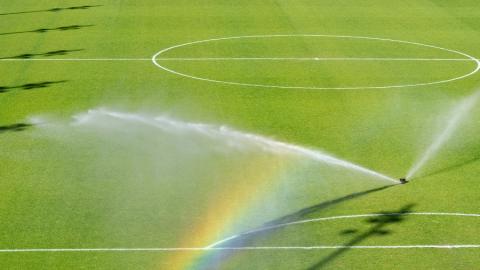The Allianz Riviera is a multi-use stadium, situated in the Saint-Isidore district of Nice, in the Alpes-Maritimes. It has about 35,000 seats. Its home club is Olympique gymnaste club Nice Côte d’Azur (OGC Nice).ITS CONSTRUCTION OFFICIALLY STARTED ON 6TH AUGUST 2011 and the work was completed in September 2013. The stadium will be one of the venues for Euro 2016.

Construction. The work, in principle, should be completed by the end of 2013, before the Francophone games, a competition that Nice is due to host. By the end of the month of May 2012, the height of the concrete walls had already reached half the total height of the stadium, i.e. some 20-odd metres out of the full 42 metres. On 1st June, half the concrete had been cast. The shell construction was completed in early November 2012. Furthermore, the installation of the 3-dimensional wood and steel structure, which covers all the terraces and was assembled between mid-September and mid-December 2012, began in October 2012 and was completed in mid-March 2013. Features. The stadium has been rated as category 3 in the UEFA stadium classifications. Its orientation is north-south and its pitch measures 131 by 73 meters.
Ecology. The project is eco-friendly. The choice of a wooden structure, rather than a metal one, is thus supposed to allow for a reduction in CO2 emissions. Photovoltaic solar panels, with a total surface area of 7,500 square metres, will also be installed on the roof, and this will be complemented with 6,000 square metres on the roof of the under - ground coach park and 2,500 square metres on the roof of one of the buildings situated at the side of the stadium and along the length of the “solar alley”. The stadium will, therefore, produce three times more energy than it consumes. Furthermore, the stadium premises are ventilated naturally and should be using the winds of the Var plain to freshen the air using the breathing wall concept. On 28th May 2010, UEFA announced that France will be organising the 2016 European Football Championship (Euro 2016). The new stadium in Nice has been selected as one of the eleven host venues for the competition (two of these being reserve stadiums), but no announcement has yet been ma de with regard to the matches to be played in this stadium. With a 35,000-seat capacity, this could be one of the stadiums hosting a quarter-final.
Background history. Almost two years after the cancellation of the old stadium project by the administrative court, the new project was relaunched almost exactly on the same spot, with the collaboration of the firm of architects, Wilmotte, the construction company, Vinci, and the design and planning consultants Egis, JFL Concept and ATE responsible for the stadium’s playing surface and the surrounding landscape areas. It is difficult to imagine how many modifications had to be made between the pilot study and completion, having to take into consideration the UEFA norms, the constraints for rugby, referees, players’ entrance, parking places, with there being no room for flexibility in the budgets, the design and planning companies responsible for landscaping, turf, irrigation, etc., arriving towards the end of the project, when there were fewer financial resources available.
As far as the project management is concerned, the technique is very important and should be carried out according to clear and straightforward specifications and applied diligently by the contractors. To obtain optimum re sults, there should be the possibility of monitoring the finances. In a Public/Private part nership, this is not the case. The main contractor controls everything and the buyers have to make rather unorthodox choices in quite unfamiliar areas (land scaping, irrigation, drainage, turf, sub strate, plants and other), and just for the record, six price negotiations had to take place with the irrigation and landscaping companies alone.
Laying the turf. Since the month of July 2013, the turf has been arriving in refrigerated trucks ready to be laid. It is made of the same grasses as those used in Real Madrid’s San tiago Bernabeu sta dium. The rolls of turf measuring 1.20 m by 15 m., were laid over a total surface area of 9,000 square metres on 31st July of this year. The turf grass was grown during the spring in the Bordeaux region, on sandy soil. To match the image of a stadium being announced as very “green” (rainwater recovery, photovoltaic panels…), innovation
is the dominant theme in the laying of the future playing surface of Claude Puel’s Aiglons team. The irrigation system is spectacular (the turf will be ventilated from below).
“the underground section is without doubt the most impressive with several sub-layers that will encourage drainage, particularly the absorption of storm waters, and they will provide aeration and oxygenation of the subsoil and prevent the deterioration of the surface”, explained Xavier Lortat-Jacob, President and CEO of Nice Eco Stadium (NES), the operator of the Allianz Riviera. A special substrate and a very precise irrigation cycle have allowed the turf to take root slowly. “We couldn’t make up our mind about whether to use synthetic or natural turf. However, this technique guarantees us good quality grass while avoiding the difficulties that Monaco has experienced at the Louis II stadium”, Christian Estrosi explained, during a visit to the construction site, which had begun on 1st July 2011.
OGC Nice will take possession of its new stadium on 19th September for the first Europa League fixture, provided they get through the play-off round (22nd and 29th August), otherwise it will be the Nice-Valenciennes match, which corresponds to the 6th fixture of Ligue 1.
A project such as this is very rewarding for the participating contractors, but we also have to bear in mind all the constraints, repetitive meetings, changes of site schedule, shifting priorities. In fact, you have to have a pretty strong temperament because the greater the delay in handing over of keys, the more tense becomes the atmosphere.
The contractors and the technique. In this stadium, the firm Parcs et Sports, under the expert leadership of JM Bridet has really come up trumps, and Vincent Savourat of ATE enthusiastically went over every detail that could affect the special characteristics of the ground and turf parameters. In late July, 25 refrigerated lorries or trucks were needed to transport the turf from Bordeaux to Nice. As regards irrigation, I have my reservations, as the buyers have cut back on important items (no weather station, no shut-off valves, no safety
features).
This is a relatively large sprinkler installation, with 3 storage tanks in the car park for recovered rainwater and the water from the air conditioning system to be used for the toilets,
sprinkling and fire fighting. We have three 20m3/hour pumps each linked to a Netafim spin
klin filtration system, a satellite/programmer and an ARRODIS central control system from Botanica. In the event of a lack of water in the tanks, a motorised valve will automatically provide a supply of water from the city’s mains system.
To manage the programming, tensiometers have been installed beneath the turf (corners, centre of the pitch and along the edges). Weather information is also entered into the system
via the weather station at Nice airport, whereas it would have been preferable to have its own meteorological station. The programming system not only manages the stadium
ut also the surrounding area of about 3 hectares, covering the car parks and green spaces, which are irrigated by Eco-friendly, to the point that it has a positive energy balance. The Allianz Riviera stadium, thought out in every single detail to reduce its environmental impact, is a sound example of energy efficiency. Nothing has been left to chance. As regards the sustainable development aspect, everything has been thought through, calculated and weighed up beforehand. This particularly applies to the ecological factor.
The objective is to minimise the impact on the environment. As regards the design, implementation and operation of the Allianz Riviera, Nice Eco Stadium and the city of Nice have set a priority: it has to be a clean building. This constant concern, allied to innovative technologies, makes the Allianz Riviera a real model of eco-design and eco-construction. It is now one of the first eco-stadiums in the world, situated right at the heart of an eco-district, where it is the leading light, its elegant outline fitting gently into its surroundings and the stadium conveniently located right next to the A8 motorway.

